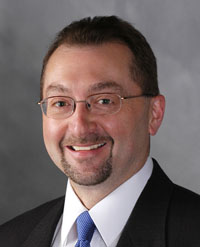By Commissioner Tom Sorel

Commissioner Tom Sorel. Photo by David Gonzalez |
Looking back on 2011, I am amazed by all that we as an agency have accomplished despite facing some incredible challenges during the past 12 months. It says a lot about the dedication, service and downright resilience of MnDOT employees. I am proud to serve and lead such a great team.
We have done so much as an agency this year to improve the way we do our work. I just want to highlight a few of these tremendous efforts.
We often say safety—to provide a safe and reliable trip for motorists—is our number one priority. Our efforts in Toward Zero Deaths this past year have supported that mission. Right now, it appears that deaths on state roads will be about 361. That is 50 fewer than last year. We have worked hard in the TZD collaboration with the Department of Public Safety, the Department of Health and a number of state and local entities to promote safety on state roadways. The program focuses on the engineering, enforcement, education and emergency medical services to reduce roadway death.
Also in 2011, we began an Enterprise Risk Management effort to improve agency operations. We conducted a risk analysis of investment levels across the categories of preservation of pavement and bridges, safety, mobility and regional and community priorities. As a result of this analysis, pavement preservation emerged as the highest risk for MnDOT and led to the development and implementation of the Better Roads program last spring. In 2012, the department will undertake a comprehensive risk-based evaluation of MnDOT operations to prioritize products and services based on their impact to quality of life.
A very significant accomplishment for MnDOT this year was the completion of the 50-year vision for transportation known as Minnesota Go. MnDOT asked Minnesotans what the transportation systems should look like and provide 50 years from now. We also consulted experts across a range of subject areas about future trends that will shape the state in that same time period. The combination of these two lines of thought defines a future transportation vision that will support the level of quality of life that Minnesotans say they want.
Regarding quality of life, MnDOT concluded an extensive effort to understand how Minnesotans think transportation affects their quality of life. Using various research methods, MnDOT learned that transportation is a key factor to most Minnesotans when they consider quality of life. We are using this information to guide operational decisions and to help develop investment criteria. We want to make sure that transportation serves as a strong contributor to quality of life.
We did a tremendous amount of work on the state’s infrastructure in 2011. Of this year’s 258 state highway and bridge projects, 180 were completed as of Dec. 20, with the remainder continuing on into 2012 and beyond. Our crews worked hard to resurface roads, replace bridges, improve drainage systems, repair guard rail, install cable barriers and complete other vital transportation projects aimed at providing a smoother ride for motorists and better accessibility for all Minnesotans, extending pavement life, improving connections between communities, and reducing highway fatalities and serious injuries.
These transportation projects received a lot of help from employees who aren’t necessarily as visible to the public as those who wear hard hats and vests—our planners, designers, accounting officers, attorneys, information technology specialists, auditors, trainers, hydrologists and so many others—but whose service has helped improve the quality of life for all Minnesotans.
Completing so many projects this year was not without its challenges—especially given the fact that for three prime weeks during the construction season (July 1-20), state government was shut down, abruptly halting all of our projects and laying off about 4,500 MnDOT employees. I was reminded a number of times during the shutdown of the importance of the work that we do to improve the safety and mobility of the traveling public, and how interconnected we are with the private sector, which also suffered the loss of jobs that our construction projects provide.
The shutdown came on the heels of saying good-bye to the last of the 415 of our friends and co-workers who elected to take the early retirement incentive. We lost a lot of experience with their exodus, but at the same time, found we had a lot of other employees ready to step up and take on new challenges. I look forward to seeing the new ideas and innovations they bring as they take on their new roles.
In August, we got word that all the information technology specialists in the state would be consolidated into the Office of Enterprise Technology. While all the ramifications of that legislative decision are still being sorted out, we know for sure that 206 of our former MnDOT employees now officially report to OET. I greatly appreciate the great work the employees who are part of the consolidation with OET have done and look forward to working with them in their new roles.
I could cover many more things because this agency has been incredibly productive and innovative this year. I want to thank all of you for your flexibility and willingness to move ahead in new directions. We live in a world where the ability to adapt and overcome is vital. And, clearly, you have all shown that you are able to move this agency forward and make it more responsive and efficient. You are all tremendous servant leaders and your efforts are a tribute to the citizens of this great state.
Thank you for all you do, and Happy Holidays! |



